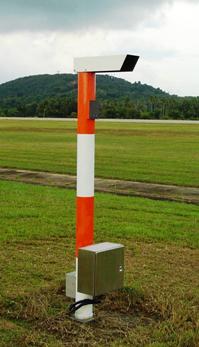
Transmissometer
Encyclopedia

Molar absorptivity
The molar absorption coefficient, molar extinction coefficient, or molar absorptivity, is a measurement of how strongly a chemical species absorbs light at a given wavelength...
of the atmosphere
Atmosphere
An atmosphere is a layer of gases that may surround a material body of sufficient mass, and that is held in place by the gravity of the body. An atmosphere may be retained for a longer duration, if the gravity is high and the atmosphere's temperature is low...
, and for the determination of visual range
Visibility
In meteorology, visibility is a measure of the distance at which an object or light can be clearly discerned. It is reported within surface weather observations and METAR code either in meters or statute miles, depending upon the country. Visibility affects all forms of traffic: roads, sailing...
. It operates by sending a narrow, collimated beam of energy (usually a laser
Laser
A laser is a device that emits light through a process of optical amplification based on the stimulated emission of photons. The term "laser" originated as an acronym for Light Amplification by Stimulated Emission of Radiation...
) through the propagation medium. A narrow field of view
Field of view
The field of view is the extent of the observable world that is seen at any given moment....
receiver at the designated measurement distance determines how much energy is arriving at the detector, and determines the path transmission
Transmittance
In optics and spectroscopy, transmittance is the fraction of incident light at a specified wavelength that passes through a sample. A related term is absorptance, or absorption factor, which is the fraction of radiation absorbed by a sample at a specified wavelength...
and/or extinction coefficient. Atmospheric extenction is wavelength
Wavelength
In physics, the wavelength of a sinusoidal wave is the spatial period of the wave—the distance over which the wave's shape repeats.It is usually determined by considering the distance between consecutive corresponding points of the same phase, such as crests, troughs, or zero crossings, and is a...
dependent phenomenon, but the most common wavelength in use for transmissometers is 550 nm, which is right in the middle of the visible waveband, and allows a good approximation of visual range.
Transmissometers are sometimes referred to as telephotometers, transmittance meters, or hazemeters.
The term transmissometer is also used by oceanographers and limnologists to refer to a device for measuring the optical properties of natural water. In this context, a transmissometer measures the transmittance
Transmittance
In optics and spectroscopy, transmittance is the fraction of incident light at a specified wavelength that passes through a sample. A related term is absorptance, or absorption factor, which is the fraction of radiation absorbed by a sample at a specified wavelength...
or attenuation
Attenuation
In physics, attenuation is the gradual loss in intensity of any kind of flux through a medium. For instance, sunlight is attenuated by dark glasses, X-rays are attenuated by lead, and light and sound are attenuated by water.In electrical engineering and telecommunications, attenuation affects the...
of incident radiation from a light source with a select wavelength, often 660 nm, through a defined cell volume.

